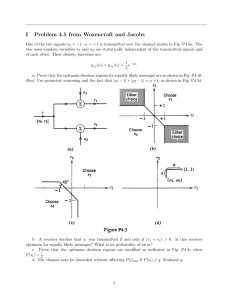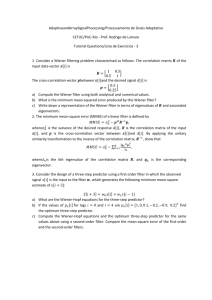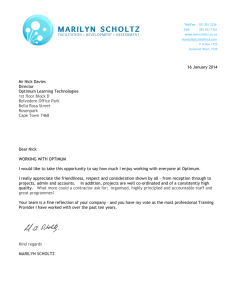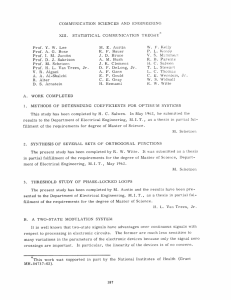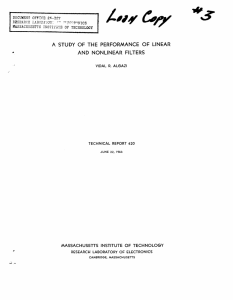Lo COM CODING WITH LINEAR SYSTEMS COSTAS
advertisement
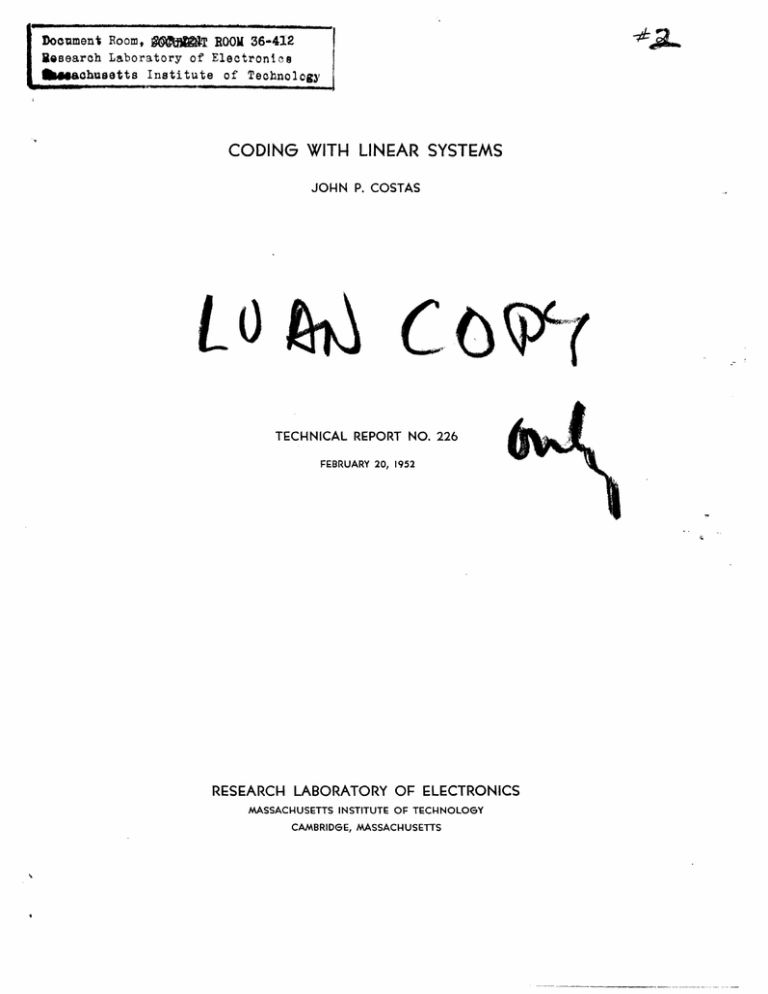
Document Room, A
T ROOM 36-412
Research Laboratory of Electronlcse
Shmachusetts Institute of Technology
CODING WITH LINEAR SYSTEMS
JOHN P. COSTAS
Lo
COM
TECHNICAL REPORT NO. 226
FEBRUARY 20, 1952
RESEARCH LABORATORY OF ELECTRONICS
MASSACHUSETTS INSTITUTE OF TECHNOLOGY
CAMBRIDGE, MASSACHUSETTS
The research reported in this document was made possible
through support extended the Massachusetts Institute of Technology, Research Laboratory of Electronics, jointly by the Army
Signal Corps, the Navy Department (Office of Naval Research)
and the Air Force (Air Materiel Command), under Signal Corps
Contract No. DA36-039 sc-100, Project No. 8-102B-0; Department of the Army Project No. 3-99-10-022.
__
MASSACHUSETTS
INSTITUTE
OF
TECHNOLOGY
RESEARCH LABORATORY OF ELECTRONICS
February 20,
Technical Report No. 226
1952
CODING WITH LINEAR SYSTEMS
John P.
Costas
Abstract
Message transmission over a noisy channel is considered.
are to be designed:
Two linear networks
one to treat the message before transmission; the second to filter
the treated message plus channel noise at the receiving end.
The mean-square error
between the actual transmission circuit output and the desired output is minimized for
a given allowable average signal power by proper network design.
The results of a
numerical example are given and discussed.
__--
__IIIIIYIIIIPUI__ll(·YI(II
I------·I
II
I
-----
CODING WITH LINEAR SYSTEMS
I.
Introduction
The importance of the statistical approach to filter design as originated by
Wiener (1, 2) and developed by Lee (3) has been discussed by this author in a forthcoming
report (4).
Briefly, for a given message plus noise input as shown in Fig. 1, we desire
to find a filter characteristic which will give the best possible performance.
By "best"
we mean that filter which minimizes the mean-square error between the actual output
S, the mean-square error of filtering, will
That is
fo(t) and the desired output fd(t).
be given by
T
C5= lim
T-oo
2T f
T -T
f1(t)
(1)
fd(t)] 2 dt.
Such an error criterion is certainly a reasonable one from a physical point of view,
but contrary to a popular notion it is by no means the only error measure amenable
to mathematical treatment (5).
The desired filter output is usually the message
fm,
!FILTER(t)
fn
(t
)J
function f(t).
NETWORK
However, it may happen that an out-
put other than the message may be required.
For
example, one might ask for a network design which
Fig. 1
would filter the message from the noise, predict
Conventional filter problem:
the message by a seconds, and differentiate the
fm(t) = message function;
fn(t) = noise function;
result.
Thus, we could require prediction, filtering,
and differentiation in one operation (3).
In this sense
fo(t) = actual filter output;
a network may be considered as an operator rather
fd(t) = desired filter output.
than simply a filter (1).
If linear systems only are to be considered,
the statistical parameters needed for design are known as the correlation functions.
The crosscorrelation function + 1 2 (T) between random functions f (t) and f (t) is defined
l
2
by
T
12(T) =
The autocorrelation function
lim
(2)
2T -fl(t)f2(t+T)dt.
-T
1 1 (T) of the random function fl(t) is defined by
T
,,(T) =
lim
T -. 00
(3)
2T1 ffl(t)fl(t+T)dt.
-T
The Fourier transform pair g(t), G(w) are related by
-1-
__ I___
- -----
I__
Iy^--·
__l~··-ll_-Y···-Y_
l--1___.__-
-- ~
-----
00
too
f
G(o) = 2
g(t) E
dt
(4)
tdw.
(5)
-00
and
00
g(t) =
G(+o)e
-00
By the Laplace transform we shall mean relations Eqs. 4 and 5 except that
is
replaced by X where
X=
+ jo-.
(6)
An important theorem due to Wiener (3, 6) states that the power-density spectrum of
a random function fl(t) is given by the Fourier transform of the autocorrelation function
of fl(t).
That is,
00
f
,()
(7)
ll(T)EJTdT.
p
-c0
In a similar manner, we may define a cross-power spectrum
12(
)
between random
functions f 1 (t) and f 2 (t) as
00
l2(o)
rrf
cl(CT) e
2=
d
T.
(8)
-00
Let us define the unit impulse u(t) by
u(t) = lim
a -
q_-a
t
o
Then we may show using Eq. 4 that the transform U(c) of u(t) is given by
U ()
=
r
(9)
Now if h(t) is the response of a linear system to a unit impulse input, it may be shown(3)
that the output fo(t) of the linear system to an arbitrary input fi(t) will be given by
00
fo(t) =
f
h(or)fi(t-)dr.
(10)
-0o
Let e(t) be the transient output of the linear system due to a transient input ei(t).
If
a system function H(o) is defined for the linear system such that
E (c)
H(o) = E( )
1iO
-2-
(11)
it may be shown that H(w) and h(t) are related by
00
H(o) =
(12)
h(t)e Jtdt
-00
and
fJH(W) E+ j tdu
h(t) =
(13)
00
which correspond to Eqs. 4 and 5 except for the location of the 2r term.
II.
The Transmission Problem
The filter design problem of Fig. 1 has been treated in great detail by both Wiener(l)
and Lee (3), with experimental verification available in the work of C. A. Stutt (8).
Therefore, in this report we shall consider the more general situation described by
Fig. 2.
In most communication systems the opportunity exists to modify or "code" the
message to be transmitted before its introduction into the transmission channel.
Net-
work H(w) must be designed so that the message is "pre-distorted" or "coded" in such
a way as to enable the "decoding" or filtering network G(w) to produce an output which
is a better mean-square approximation to the desired output than would be possible if
the untreated message were put into the transmission channel.
The mean-square error between f (t) and fd(t) of Fig. 2 will be
00
T
=lim
dt
2T
-T
dg(cr)fn(t-
) +
-00
00
jdg(o)
g()
-
00-
- 00O
dvh(v)fm(t-C-v)
. (14)
When expanded Eq. 14 may be rewritten in terms of correlation functions as
-00
+
-00
-00
f
f f
f
_ 00
- 00 - 00
00
- 2 f
-00
-00 -00
/
(
c-v)
d/pdidcdvg(O)h(~)g(cr)h(v)4mm( p+a-
2
f
dcrg(cr)qnd(c)
- 00
- 00
00
f ddvg(o)h(v)pmd(+v) +
dd().
(15)
-00
Impulse response functions g(t) and h(t) must be found which minimize
which may be realized by physical networks.
g(t), h(t) = 0
of Eq. 15 and
That is
for t < 0.
(16)
3-
;.
_
_C
_
II__·I__I____UqPIYYI__II---IILIP·IIU
ll-Cllli-
II
-
fn (t)
Fig. 2
Transmission circuit.
An additional constraint must be imposed on the coding network H(w) with regard to
average transmitted signal power,
but this need not be considered at this point.
As a first approach let us assume that H(w) is fixed and solve for an optimum G(c).
This may be done by letting g(t) of Eq. 15 take on an admissible variation
(t) = 0
and
is a parameter independent of
g(t) + vei(t) and replace & by
+
for t < 0
and h.
6.
That is,
E
(t) where
(17)
we replace g(t) of Eq. 15 by
Now if a certain g(t) gives minimum mean-square
error, then certainly this optimum g(t) must also satisfy
a(e +
SE
= =0.
(18)
An expansion of Eq. 18 by using Eq. 15 results in
fdvg(v)nn(a-v)
- o
+
f
f
dadvh(v)g()qnm (a-ca-v)
-oo -oo
f
-00
+
f didvh(vl
nmlv
l
-00
00
oo
~nd(0) -
f dvh(v)( md(a+v)
-00
= q(o)
where q(o()
(19)
is a function defined by
q(o) = O
for o > 0.
(20)
Now taking the Laplace transform of Eq. 20 with respect to cr one obtains
G(X)F(X) - Pnd(X) - H(-X)md(k) = Q(X)
(21)
-4-
I
I·
where F(X) is by definition
F(X) = H(X)H(-X) mm(X) + H(X)nm(X) + H(-X)mn (X) +
nn(X).
(22)
We shall assume that F(X) is factorable into
F(X) = F+(X)
(23)
F-(X)
where F (X) has all its poles and zeros in the upper half of the X plane, and F (X) has
all its poles and zeros in the lower half of the X plane.
Equation 21 may then be written
with the aid of Eqs. 4, 5, and 6 as
G(X)F G(X)F+
(X) -
1
Xt-jtdt
j
f
0
e
+ H(W)md(w)
E+jwt
(w)
Edw
-00
0O
r
~nd()
oo
f
jrt dt
-00
nd(w ) +H(w)md(W)
+jwt dw
-00
FQ()
(24)
The first two terms on the left-hand side of Eq. 24 have all their poles, if any, in the
upper half of the X plane, while the third term on the left has all its poles in the lower
Since the right-hand side of Eq. 24 has poles only in the lower-half
half of the X plane.
plane, the first two terms on the left, when taken together,
must equal a constant.
It
can be shown that this constant is zero, thus yielding
G(X)
=
1
0
2rF+(X)
0
f
-jkt
00
nd(w)
dt
E
+
H( w)md(w)
+ H( w)mw
jwt dw
dw
(25)
-00
For a fixed H(X) network of Fig. 2, Eq. 25 gives the optimum transfer function for the
decoding network.
The system function G(X) given by Eq. 25 is always realizable.
Two special cases of Eq. 25 are of interest.
F(k) =
M(k) +
First choosing H(X) = 1, we have
nm(k)
) ++
nn(X)
(26)
-ii(
).
Thus, F(X) becomes the Fourier transform of the autocorrelation function of the G network input.
We then have for G(X)
G(X)
=
1
r
jdt
represents
desired output.
+wdw
(27)
-00
0
where bid()
w )
i ((w)
the cross-power spectrum between the filter input and the
Equation 27 is the optimum filter formula of Wiener and Lee and is
-5-
_1__1_1_·__111____Y·l·LULII---I
I1-
_
I
^_ ---I-_I__
the solution to the problem of Fig.
1.
The second special case of interest occurs when the noise function of Fig. 2 is made
zero.
Then Eq. 25 becomes
G(x)
E -j=t
f
dt
m 00HWmm
mm
o
H(-w)md(w)
(28)
E+jWtdw
-o
where
H+(X)H-(X) = H(X)H(-X)
(28a)
which is the so-called "optimum compensator formula. " Equation 28, though previously
unpublished, was first derived by Y.
W. Lee.
If the network G(w) of Fig. 2 is considered fixed, then by exactly the same methods
used above, we will find that the optimum H(X) will be given by
00
00G-w)
G+(W)mn
G -(W~) -md(W)
mm
dt
H(X) = 2EwG+(k)+
/Tktdt
0()
mmX
2r
/
-0L
w
4
(
mm
where
G+(X)G-(X)
]
)
m(W)
E+jwt
= G(X)G(-X).
dw
(29)
(29a)
If the channel noise is zero or if the crosscorrelation between the message and noise
is zero, Eq. 29 reduces to an optimum compensator formula.
Equation 25 gives the optimum G(X) for a fixed H(X) while Eq. 29 gives the optimum
H(X) for fixed G(k).
If a simultaneous solution of Eqs. 25 and 29 is performed, one would
obtain the optimum coding-decoding pair of networks for the transmission circuit of
Fig. 2.
However, before such a solution is attempted, it will be convenient to solve
for the mean-square error resulting from fixing H(k) and optimizing G(X).
of Eq.
Substitution
19 into Eq. 15 yields
o00
min
xed)=
dd()
-
f
00
drg(r-)n
d
o
C)-
-00
fdodvg(-)h(v)d(+
-oo
v).
(30)
-
This equation may be rewritten in terms of Fourier transforms as
00
(H Fixed)
fd
{dd(C)
--
nd(w)G(-w) - G(-w)H(-w) mdo(31)
It must be remembered that g(o-) and G(o) of Eqs. 30 and 31 are not arbitrary but are
solutions of Eq.
III.
19.
Long-Delay Solution
In solving for the optimum pair of networks of Fig. 2, we shall assume that the
crosscorrelation between the message and the channel noise is zero.
We shall further
-6-
-·I
II
the desired output shall be the message delayed.
accept a long-delay solution; that is,
Thus
fd(t) = fm(t-a),
(32)
a-oo
and
md(O) =
Under these conditions,
mm(c) E j,
a-o.
-
(33)
o.
(34)
Eq. 25 may be rewritten as
H(-w)
(X) jaW
a
G(w)
mm
,
H() mm
a-
nn
Since best possible filtering results when long delays are permitted (3),
substitution of
Eq. 34 into Eq. 31 will result in the lowest possible error, the so-called irremovable
Thus, we have finally
error.
00
,(H Fixed) =
irr
nn
mm(
i
(W) + (I
f I H(w) 12~p
00 H()I 2 mm()
nn
(35)
dw.
Note that the irremovable error is dependent only upon the magnitude of the transfer
function of H(w),
not upon the phase.
Equation 34 shows that any phase contribution due
to a fixed H(w) will be removed by the optimum decoding network G(w).
For a given H(w), Eq. 35 will give the resulting transmission error provided network
Thus, we must find an H(w) which makes the error
G(w) is designed according to Eq. 34.
of Eq. 35 a minimum and at the same time keeps the average transmitted signal power
constant.
That is,
we must require that
00
2
f IH()
(36)
= c1
mm()d)
-00
|
H(w) 2mm(w) represents the power-density spectrum of the output of the coding
since
network.
If we let
y'() 2
Eqs.
H()
mm(W)
(37)
35 and 36 may be rewritten as
irr
mm
=
0
nn
(38)
do
[y()] 2 + nn(w)
and
o00
y()]
f
2
dw =
(39)
1/2.
0
-7-
------- -------- IL-----
- _.
__
__
____
__
We now seek that real-valued function y(w) which minimizes Eq. 38 and in addition satisfies Eq. 39. This is the so-called isoperimetric condition of the calculus of variations.
By applying the usual techniques (9), one obtains
IH()
nn(
=
12 mm(O)
mm()
+
)
(40 a)
nn()
and
2
IH()I
(40b)
mm (W) = 0
where y is a constant which must be adjusted to satisfy Eq. 39.
Equation 40a is used
where the right-hand side is positive, otherwise Eq. 40b must be used.
Physically this
means that H(w) may contain stop bands; however, the existence of such stopbands is in
no sense a violation of the Paley-Wiener theorem (1, 10, 11) as an infinite delay time
through H(w) and G(o) is assumed.
IV.
Discussion of Results
As a check on the results of section III, a noise spectrum
2
(41)
nn(O) = a
and a message spectrum
mm()
were assumed.
When 2a2
2
+
z
2T
(42)
was chosen equal to 1/5 r1 and c
gave a mean-square error of 0. 285.
was made unity, Eq. 38
Without coding and using the same average signal
power, the mean-square error was found to be 0. 302.
(This was computed from Eq. 35
H(c) 2 equal to unity.) Thus, the optimum coding network gave some transmission improvement but not a considerable amount. For the particular case cited, no
by setting
transmission is allowed by H(c) beyond w = 8. 45 P, and when the noise level was raised
by a factor of five, this upper cut-off frequency moved down to
= 3. 25 P.
It can be shown that a communication circuit using amplitude modulation can be
represented by Fig. 2 (ref. 4).
The use of frequency modulation complicates matters
but it has been suggested that noise spectra of the form
Mnn(c)
= a o
might be meaningful.
(43)
Using the message spectrum of Eq. 42 and the noise spectrum of
Eq. 43, it was found that only a moderate improvement resulted using optimum coding
or "pre-emphasis" networks.
The moderate improvement in mean-square error shown above is due in part to the
particular spectra assumed. Therefore, in certain instances a considerable improvement might be realized by using proper coding networks.
-8-
References
1.
2.
N. Wiener: The Extrapolation, Interpolation, and Smoothing of Stationary Time
Series with Engineering Applications, John Wiley, New York, 1949
N. Wiener: Cybernetics, John Wiley, New York, 1948
5.
Y. W. Lee: Course 6. 563, Statistical Theory of Communication, Class Notes,
M. I. T. unpublished
J. P. Costas: Interference Filtering, Technical Report No. 185, Research Laboratory of Electronics, M. I. T. March 1951
Y. W. Lee: Memorandum on Error Criteria in Filter Design, unpublished
6.
N. Wiener:
7.
Y. W. Lee, C. A. Stutt: Statistical Prediction of Noise, Technical Report No. 129,
Research Laboratory of Electronics, M. I. T. July 1949
C. A. Stutt: An Experimental Study of Optimum Linear Systems, Doctoral Thesis,
Dept. of Electrical Engineering, M. I. T. May 15, 1951
H. Margenau, G. M. Murphy: The Mathematics of Physics and Chemistry, Van
Nostrand, New York, 1943
G. E. Valley, Jr., H. Wallman: Vacuum Tube Amplifiers, McGraw-Hill, New
York, 1948
R. Paley, N. Wiener: Fourier Transforms in the Complex Domain, Am. Math.
Soc. Colloq. Pub. 19, 1934
3.
4.
8.
9.
10.
11.
117-258, 1930
Generalized Harmonic Analysis, Acta Math. 55,
Acknowledgment
The author wishes to thank Professor Y. W. Lee, Dr. C. A. Stutt, and Mr. C. A.
Desoer of the Research Laboratory of Electronics, M.I.T. for their many helpful
comments and suggestions.
-9-
_ ______1___1_1____1__I_
L
-·II-.
_
_ -I_---_
-
-1_1_1_111·-s
I ~~~ ~
~ ~~~~~~~~~I-
